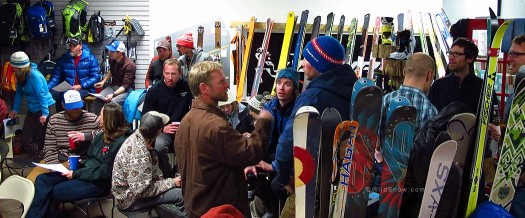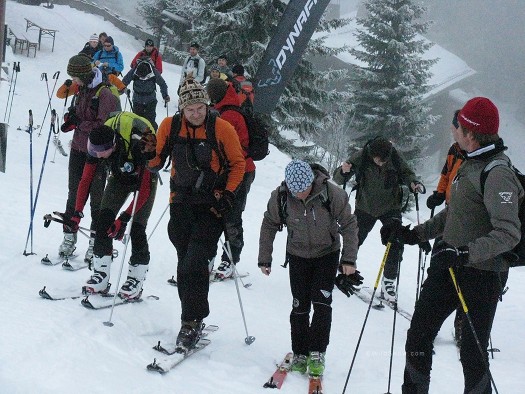Photos by Randall Young

An evening of camaraderie and spirited talk about avalanche awareness at Cripple Creek Backcountry, Carbondale, Colorado.
Group psychology and dynamics (take your pick for the more PC terminology) are topics that sometimes receive little attention in avalanche classes and lectures. However, in the last several years, some of our worst backcountry avalanche tragedies appear to have resulted at least in part from poor group dynamics — proof that avalanche safety means looking up from your snow pit and paying attention to what is going on within your crew.
How do we begin discussion on group dynamics in the backcountry? A few days ago we stuffed 40 ardent backcountry skiers into our ski shop (Cripple Creek Backcountry, Carbondale, Colorado’s own specialized backcountry retailer) and gave them the opportunity to share tips, tricks, and their own experiences. Although some incredible insights were provided from mediators, local avalanche forecaster Blase Reardon and big mountain climber Michael Kennedy, the open forum atmosphere led to profound words from many other members of Carbondale’s backcountry community. A summary:
Group size: Three to four people is an ideal size for backcountry travel. If the group exceeds four, group dynamics are hard to manage and one person may need to step up and take charge. Tip: initiating the transceiver test is a great way to exert some leadership as well as shift a group’s focus towards safety.

What's your group size? This tour in Europe is typical of the Alps but we see these sorts of large groups in the U.S. as well: too many people for safe group dynamics unless firm leadership is provided by a guide or defacto guide.
Veto power! If one member of the group says no to a situation, the decision has been made for everyone. Consensus is not the goal of backcountry decisions unless it is towards the more conservative choice. Think about this. Choose partners with similar risk tolerance, but just as importantly ski with groups who agree on the veto power principle, and SPEAK UP if you feel uncomfortable. Conversely, if you “wear the expert halo” be sensitive to the tendency to over-sell your decisions once someone does speak up.
Herd mentality: If there is a skin track in, it will be followed and if there are ski tracks, it will be skied. But as we all know this doesn’t make it the correct choice. Think for yourself in the backcountry. This means stepping up and voicing your opinion in a group rather than deferring to the more experienced.
Ask questions don’t make statements: A simple change from, “This looks good. We should ski it.” to “Does this look good? Should we ski it?” really alters how the group approaches the next descent. Making statements closes down group communication while asking questions opens important dialog. (Editor’s note from Lou: What comes to my mind is the famed “feels really solid” stated by many people who subsequently got caught in avalanches, including myself.)
Recap your day: Whether it is in the car, in the bar, or in your personal backcountry journal, reviewing your decisions and situations is important. “Did we get it, or did we get away with it?” Don’t mistake the fact that you didn’t get caught for a good decision. Ask questions like “When were we at the most risk today?” to facilitate conversation evaluating decision-making.
The next step is opening the discussion to thousands of more voices on the web. Don’t wait until the next disaster to voice your opinion. If you have some group dynamics tricks you use to stay safe, or have an opinion, share your comments here!
(WildSnow guest blogger Doug Stenclik is co-owner of Cripple Creek Backcountry, the local shop only a few blocks from WildSnow HQ. While he’s working on his group dynamics, his tried and true solution to avalanche danger is to only skimo race when the danger rises too high. When asked about the group dynamics of racing, he says it’s all about who hands you a beer at the finish line.)
Doug Stenclik is an avid skimo racer and ski mountaineer who lives for sharing the amazing sports of ski touring and splitboarding. Since his first time on skins he was hooked and the obsession has taken him all over the United States and the world pursuing the human powered ski turn. He founded Cripple Creek Backcountry in 2012 and took over the Colorado Ski Mountaineering Race Cup in 2014 to spread knowledge and the love of the sport. In 2019 he took a step back from the ski shop and race promoter life to become a publishing partner with WildSnow.
